Harm reduction program and hepatitis C prevalence in people who inject drugs (PWID) in Iran: an updated systematic review and cumulative meta-analysis
- PMID: 33482831
- PMCID: PMC7825164
- DOI: 10.1186/s12954-020-00441-9
Harm reduction program and hepatitis C prevalence in people who inject drugs (PWID) in Iran: an updated systematic review and cumulative meta-analysis
Abstract
Background: Prevalence of hepatitis C virus (HCV) infection among people who inject drugs (PWID) in Iran is high. Since 2005, the Iranian government has implemented a harm reduction program to control HCV. We aimed to describe the prevalence of HCV antibody (Ab) in Iranian PWID before and after the implementation of harm reduction with cumulative meta-analysis.
Methods: Following PRISMA guidelines, we conducted a systematic review and meta-analysis of studies published on the seroprevalence of HCV among PWID. We systematically reviewed the literature to identify eligible studies up to December 2018 in international and national databases. Pooled prevalence and 95% confidence intervals were calculated using Der Simonian and Laird method, taking into account conceptual heterogeneity. Subgroup analyses were performed by harm reduction implementation and studies' characteristics to assess the sources of heterogeneity. We used Cochran-Armitage test for the linear trend of the prevalence of HCV Ab among PWID.
Results: We reviewed 5966 papers and reports and extracted data from 62 eligible records. The pooled HCV Ab prevalence among PWID in Iran was 46.5% (95% confidence interval [95% CI] 41.1-52.0%). Overall, the Cochran-Armitage test for trend indicated a significant decreasing trend of HCV Ab prevalence (P = 0.04). The cumulative meta-analysis showed a slight decline in the prevalence of HCV Ab between the years 2005 and 2018.
Conclusions: The HCV Ab prevalence among PWID in Iran is high, with a considerable geographical variation. The prevalence of HCV Ab among PWID in Iran slightly decreased after 2005 which could be, at least to some extent, related to the implementation of extensive harm reduction programs in the country.
Keywords: HCV; Harm reduction; Intravenous drug use; Iran.
Conflict of interest statement
The authors declare that they have no competing interests.
Figures
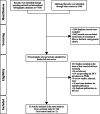
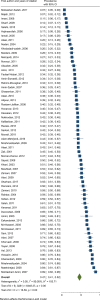


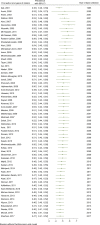





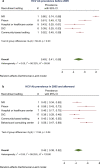
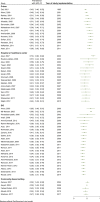
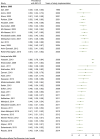

Similar articles
-
Global, regional, and national estimates of hepatitis C virus (HCV) infection incidence among people who inject drugs and number of new annual HCV infections attributable to injecting drug use: a multi-stage analysis.Lancet Gastroenterol Hepatol. 2025 Apr;10(4):315-331. doi: 10.1016/S2468-1253(24)00442-4. Epub 2025 Feb 21. Lancet Gastroenterol Hepatol. 2025. PMID: 39993400 Free PMC article.
-
Global prevalence of injecting drug use and sociodemographic characteristics and prevalence of HIV, HBV, and HCV in people who inject drugs: a multistage systematic review.Lancet Glob Health. 2017 Dec;5(12):e1192-e1207. doi: 10.1016/S2214-109X(17)30375-3. Epub 2017 Oct 23. Lancet Glob Health. 2017. PMID: 29074409 Free PMC article.
-
HIV among people who inject drugs in the Middle East and North Africa: systematic review and data synthesis.PLoS Med. 2014 Jun 17;11(6):e1001663. doi: 10.1371/journal.pmed.1001663. eCollection 2014 Jun. PLoS Med. 2014. PMID: 24937136 Free PMC article.
-
Effectiveness of needle and syringe Programmes in people who inject drugs - An overview of systematic reviews.BMC Public Health. 2017 Apr 11;17(1):309. doi: 10.1186/s12889-017-4210-2. BMC Public Health. 2017. PMID: 28399843 Free PMC article.
-
Prevalence of hepatitis C virus infection among high-risk groups in Iran: a systematic review and meta-analysis.Public Health. 2018 Aug;161:90-98. doi: 10.1016/j.puhe.2018.04.011. Epub 2018 Jun 21. Public Health. 2018. PMID: 29935474
Cited by
-
Annual trends of hepatitis C virus infection in Manitoba between 1998 and 2018: A focus on special populations.Can Liver J. 2023 Jul 26;6(2):249-260. doi: 10.3138/canlivj-2022-0030. eCollection 2023 Jul. Can Liver J. 2023. PMID: 37503521 Free PMC article.
-
Hepatitis C Virus Coinfection in People With Human Immunodeficiency Virus in Iran: A Systematic Review and Meta-Analysis.Open Forum Infect Dis. 2022 Sep 21;9(10):ofac477. doi: 10.1093/ofid/ofac477. eCollection 2022 Oct. Open Forum Infect Dis. 2022. PMID: 36267256 Free PMC article.
-
Hepatitis C virus prevalence, determinants, and cascade of care among people who inject drugs in Iran.Drug Alcohol Depend. 2023 Feb 1;243:109751. doi: 10.1016/j.drugalcdep.2022.109751. Epub 2023 Jan 2. Drug Alcohol Depend. 2023. PMID: 36621200 Free PMC article.
-
Injection cessation and relapse to injection and the associated factors among people who inject drugs in Iran: The Rostam study.Subst Abuse Treat Prev Policy. 2023 Nov 29;18(1):72. doi: 10.1186/s13011-023-00583-6. Subst Abuse Treat Prev Policy. 2023. PMID: 38031110 Free PMC article.
-
Finding the Context of High-Risk Behavioral Factors and the Effectiveness of Addiction Treatment Centers in Preventing the Transmission of Hepatitis C Virus Among Injecting Drug Addicts: "Southeastern Iran".Health Sci Rep. 2025 Mar 3;8(3):e70501. doi: 10.1002/hsr2.70501. eCollection 2025 Mar. Health Sci Rep. 2025. PMID: 40041775 Free PMC article.
References
Publication types
MeSH terms
Substances
LinkOut - more resources
Full Text Sources
Other Literature Sources
Medical

